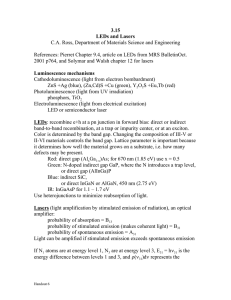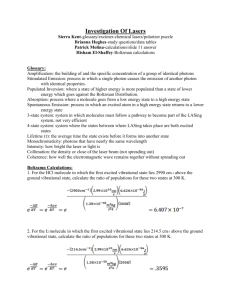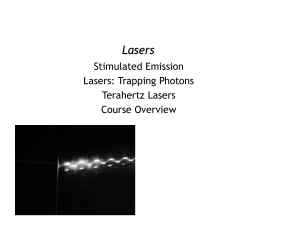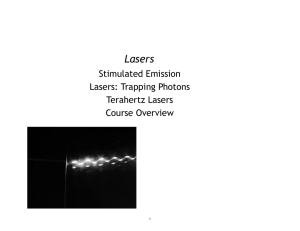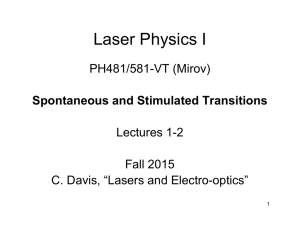Microsoft Word - HO6
advertisement
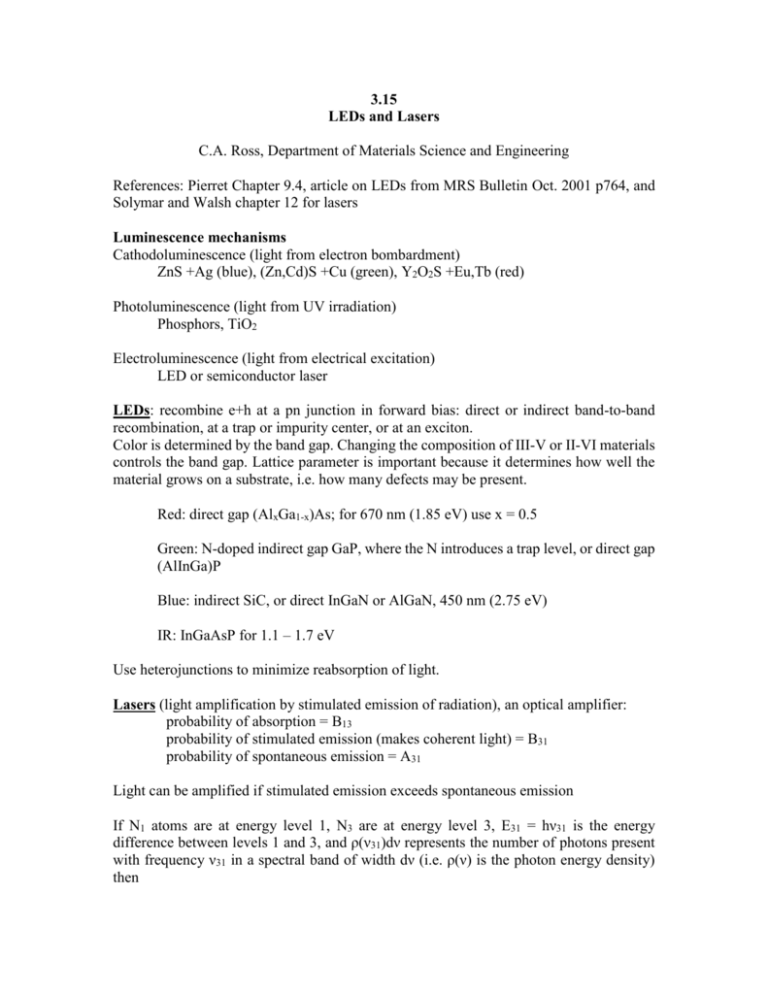
3.15
LEDs and Lasers
C.A. Ross, Department of Materials Science and Engineering
References: Pierret Chapter 9.4, article on LEDs from MRS Bulletin Oct. 2001 p764, and
Solymar and Walsh chapter 12 for lasers
Luminescence mechanisms
Cathodoluminescence (light from electron bombardment)
ZnS +Ag (blue), (Zn,Cd)S +Cu (green), Y2O2S +Eu,Tb (red)
Photoluminescence (light from UV irradiation)
Phosphors, TiO2
Electroluminescence (light from electrical excitation)
LED or semiconductor laser
LEDs: recombine e+h at a pn junction in forward bias: direct or indirect band-to-band
recombination, at a trap or impurity center, or at an exciton.
Color is determined by the band gap. Changing the composition of III-V or II-VI materials
controls the band gap. Lattice parameter is important because it determines how well the
material grows on a substrate, i.e. how many defects may be present.
Red: direct gap (AlxGa1-x)As; for 670 nm (1.85 eV) use x = 0.5
Green: N-doped indirect gap GaP, where the N introduces a trap level, or direct gap
(AlInGa)P
Blue: indirect SiC, or direct InGaN or AlGaN, 450 nm (2.75 eV)
IR: InGaAsP for 1.1 – 1.7 eV
Use heterojunctions to minimize reabsorption of light.
Lasers (light amplification by stimulated emission of radiation), an optical amplifier:
probability of absorption = B13
probability of stimulated emission (makes coherent light) = B31
probability of spontaneous emission = A31
Light can be amplified if stimulated emission exceeds spontaneous emission
If N1 atoms are at energy level 1, N3 are at energy level 3, E31 = hν31 is the energy
difference between levels 1 and 3, and ρ(ν31)dν represents the number of photons present
with frequency ν31 in a spectral band of width dν (i.e. ρ(ν) is the photon energy density)
then
rate of photon absorption in range dν R13 = N1 B13 ρ (ν 31)dν
rate of photon emission in range dν R31 = N3 B31 ρ (ν 31)dν + N3A31dν
at equilibrium, R13 = R31
also N3 = N1 exp (-hν 31 /kT)
therefore ρ (ν 31)dν = A31/{ B13 exp (hν 31 /kT) – B31 } dν
Planck’s expression for black body radiation gives the photon energy distribution, for all ν
ρ (ν )dν = {8π hν 3/c3 }/{exp (hν /kT) - 1} dν
Comparing the two expressions implies
B13 = B31
and A31/B31 = 8π hν (Einstein relations)
Usually N3 < N1 so absorption occurs more often than spontaneous emission.
To make an amplifier, we need a population inversion, i.e. N3 > N1, to produce a gain > 1.
N3 > N1 ensures that stimulated emission exceeds absorption.
gain = number of photons produced per incident photon ∝ (N3 – N1) B31 ρ (ν 31)dν
gain exceeds 1 over a small range of wavelengths around ν 31.
A population inversion can be produced in a three or four level system by pumping atoms
up to a high energy level, from which they slowly decay into a lower level. Pumping
requires a higher energy than hν31.
Energy states in a Nd3+ atom in Nd:YAG laser make a 4-level system, which lases at
1.064µ m (IR)
Energy states in a Cr3+ atom in ruby laser make a 3-level system, which lases at
693nm (red)
To raise gain we also need to increase ρ (ν 31)dν which is done by confining the light inside
a cavity, length d; this ensures that stimulated emission exceeds spontaneous emission.
cavity modes exist when ν = c/2Nd, N an integer.
Semiconductor lasers
A p+n+ degenerate junction can give a population inversion (need more electrons in
conduction band than in valence band for population inversion).
At low forward bias it acts as a LED, but when the applied voltage > bandgap it can act as
a laser.
More efficient to use a heterostructure to trap carriers in a small region. Note in
heterostructures when bands join, there is a band offset (Δ Ec or Δ Ev).
example: n-AlGaAs – GaAs – p-AlGaAs laser.
e&h are injected into the GaAs region and cannot escape. Light is also confined due to the
difference in refractive index. Cavity is defined by cleaving the crystal. Cladding and
active region need a good lattice match to avoid defects.
Blue lasers: ZnSSe cladding, CdZnSe active, or
AlGaN cladding, GaInN active.
